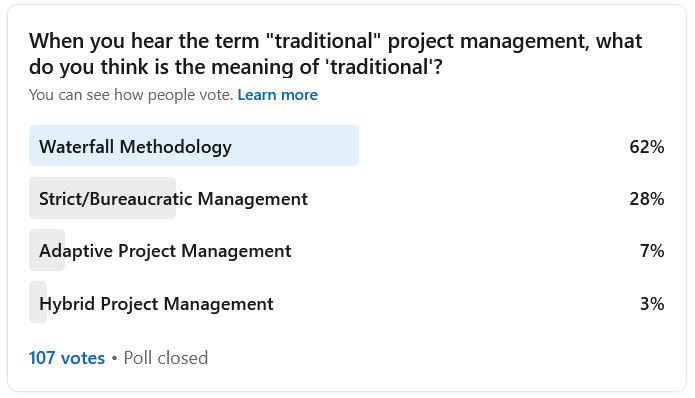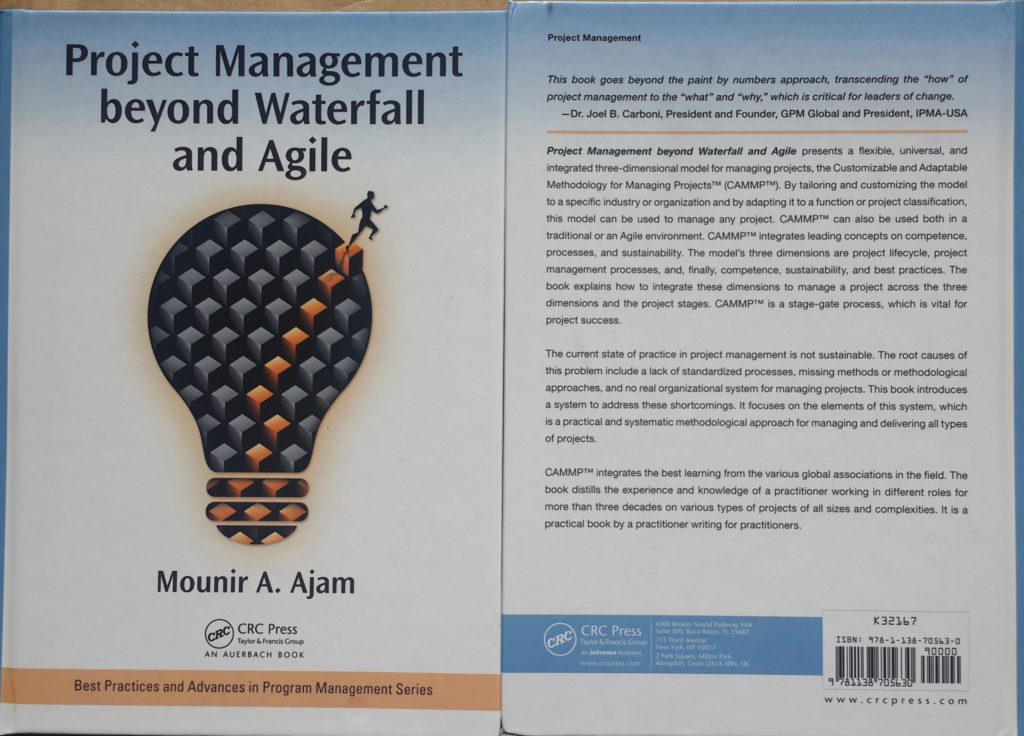We have published a poll on LinkedIn asking this question: “When you hear the term ‘traditional project management,’ what do you think is the meaning of ‘traditional’?”
Here the result of the poll

It is clear from the result, although only 107 votes, that a majority believe that the common view is that traditional project management is the same as ‘Waterfall.’ Further, many believe that traditional is bad (Strict/Bureaucratic).
Waterfall Project Management Methodology
We expected these results, and we knew that was the common view. Therefore, a while back, we wrote an article that “Waterfall Project Management” is a myth and illogical. The article is here and would shed some light on the topic.
Response to Poll
In summary, we realize the common thinking is that most people believe that the term “traditional” means “waterfall” in the context of PM Methodology. However, I really do not believe that Agile or Waterfall are project management methodologies. Agile is about (1) Agility or (2) Agile Development. “Waterfall” is a term mostly promoted by Agile people to justify Agile.
Consequently, I am open to any challenge of these statements. So, the point to ponder is: can anyone explain to us:
- What is Waterfall PM? How does the project life cycle look like in a “Waterfall”?
- The same question for Agile PM
In the article referenced above, we answered these questions.
What is traditional PM?
Maybe we are biased, but the way we see traditional PM is the well-established project management practices, i.e., competent project managers, not imposters PM. In other words, ‘Traditional Project Management’ is ‘Adaptive Project Management.’ Therefore, any competent project manager that works in a PM Mature Organization understands that the PM Practice and Methods are always adaptive!
What is Hybrid Project Management?
In our views, Agile people have been promoting Agile as THE ANSWER. They have done this for years and bombarded us with numerous certifications on the subject. Further, they advocate “Agile Transformation” as a must for organizations to do projects and all industries. However, some are starting to recognize that Agile is not good enough in recent years, primarily because Agile is about development, not management. Would these people admit the shortcomings? No way! So, what is the solution?
Can we go back to traditional project management?
Sure, but that means admitting defeat and appearing as hypocrite!
Then, what to do?
Invent Hybrid.
The Irony is that hybrid is supposedly between Waterfall and Agile, yet neither is a project management methodology. It is like combining an electric engine and a gasoline engine and say we have a hybrid house. Therefore, how do we combine two non-pm-methods and the blend is a pm-method?
If one looks at hybrid PM, we will see a traditional project life cycle with the incremental or iterative development phase. That is a form of traditional project management, traditional, adaptive, competent, project management.
Closing Comments
I came from a capital projects background, building petroleum and petrochemical facilities. In that world, we build industrial facilities. Therefore, we follow traditional project management, with sequential/overlapping phases. However, when we approach construction, we could use many techniques to build the plant (factory, chemical plant, refinery). We could use:
- Stick-built approach: simply ship everything to the construction site and build on the site.
- Pre Assembly: we use this term to means build on-site but with some items pre-assembled in a factory and shipped as “skid-mounted units.”
- Modular Construction: This could be where a large part of the “plant” is built in huge Modules and shipped to the site to be assembled like Legos.
In other words, the construction methods might change, but in all cases for the management of the project, we use “traditional project management” with “traditional project life cycle.” Only the tools or techniques would change.
Finally, here is how SUKAD and CAMMP view Project Management.

A reference


This is a topic which is close to my heart… Many thanks!
Where are your contact details though?